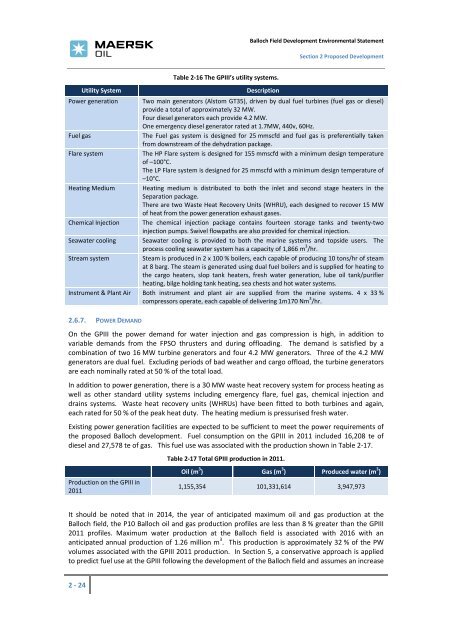Environmental Statement - Maersk Oil
Environmental Statement - Maersk Oil
Environmental Statement - Maersk Oil
You also want an ePaper? Increase the reach of your titles
YUMPU automatically turns print PDFs into web optimized ePapers that Google loves.
2 ‐ 24<br />
Table 2‐16 The GPIII’s utility systems.<br />
Utility System Description<br />
Balloch Field Development <strong>Environmental</strong> <strong>Statement</strong><br />
Section 2 Proposed Development<br />
Power generation Two main generators (Alstom GT35), driven by dual fuel turbines (fuel gas or diesel)<br />
provide a total of approximately 32 MW.<br />
Four diesel generators each provide 4.2 MW.<br />
One emergency diesel generator rated at 1.7MW, 440v, 60Hz.<br />
Fuel gas The Fuel gas system is designed for 25 mmscfd and fuel gas is preferentially taken<br />
from downstream of the dehydration package.<br />
Flare system The HP Flare system is designed for 155 mmscfd with a minimum design temperature<br />
of –100°C.<br />
The LP Flare system is designed for 25 mmscfd with a minimum design temperature of<br />
–10°C.<br />
Heating Medium Heating medium is distributed to both the inlet and second stage heaters in the<br />
Separation package.<br />
There are two Waste Heat Recovery Units (WHRU), each designed to recover 15 MW<br />
of heat from the power generation exhaust gases.<br />
Chemical Injection The chemical injection package contains fourteen storage tanks and twenty‐two<br />
injection pumps. Swivel flowpaths are also provided for chemical injection.<br />
Seawater cooling Seawater cooling is provided to both the marine systems and topside users. The<br />
process cooling seawater system has a capacity of 1,866 m 3 /hr.<br />
Stream system Steam is produced in 2 x 100 % boilers, each capable of producing 10 tons/hr of steam<br />
at 8 barg. The steam is generated using dual fuel boilers and is supplied for heating to<br />
the cargo heaters, slop tank heaters, fresh water generation, lube oil tank/purifier<br />
heating, bilge holding tank heating, sea chests and hot water systems.<br />
Instrument & Plant Air Both instrument and plant air are supplied from the marine systems. 4 x 33 %<br />
compressors operate, each capable of delivering 1m170 Nm 3 /hr.<br />
2.6.7. POWER DEMAND<br />
On the GPIII the power demand for water injection and gas compression is high, in addition to<br />
variable demands from the FPSO thrusters and during offloading. The demand is satisfied by a<br />
combination of two 16 MW turbine generators and four 4.2 MW generators. Three of the 4.2 MW<br />
generators are dual fuel. Excluding periods of bad weather and cargo offload, the turbine generators<br />
are each nominally rated at 50 % of the total load.<br />
In addition to power generation, there is a 30 MW waste heat recovery system for process heating as<br />
well as other standard utility systems including emergency flare, fuel gas, chemical injection and<br />
drains systems. Waste heat recovery units (WHRUs) have been fitted to both turbines and again,<br />
each rated for 50 % of the peak heat duty. The heating medium is pressurised fresh water.<br />
Existing power generation facilities are expected to be sufficient to meet the power requirements of<br />
the proposed Balloch development. Fuel consumption on the GPIII in 2011 included 16,208 te of<br />
diesel and 27,578 te of gas. This fuel use was associated with the production shown in Table 2‐17.<br />
Production on the GPIII in<br />
2011<br />
Table 2‐17 Total GPIII production in 2011.<br />
<strong>Oil</strong> (m 3 ) Gas (m 3 ) Produced water (m 3 )<br />
1,155,354 101,331,614 3,947,973<br />
It should be noted that in 2014, the year of anticipated maximum oil and gas production at the<br />
Balloch field, the P10 Balloch oil and gas production profiles are less than 8 % greater than the GPIII<br />
2011 profiles. Maximum water production at the Balloch field is associated with 2016 with an<br />
anticipated annual production of 1.26 million m 3 . This production is approximately 32 % of the PW<br />
volumes associated with the GPIII 2011 production. In Section 5, a conservative approach is applied<br />
to predict fuel use at the GPIII following the development of the Balloch field and assumes an increase








